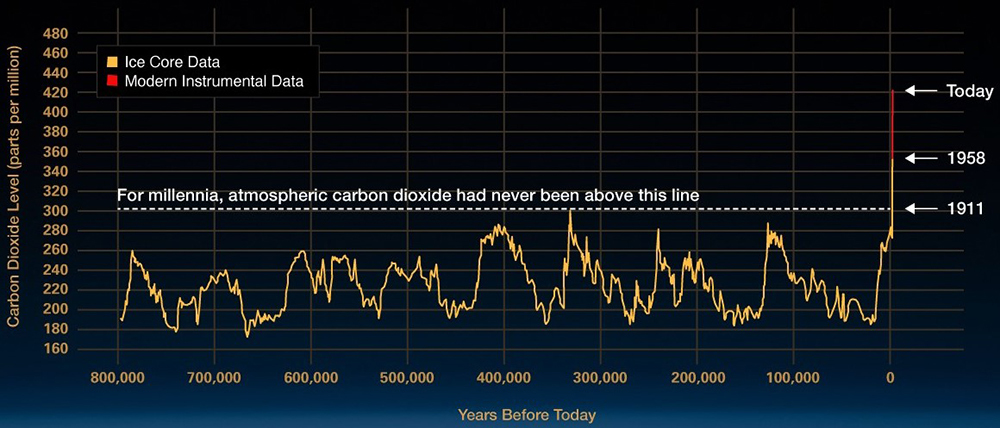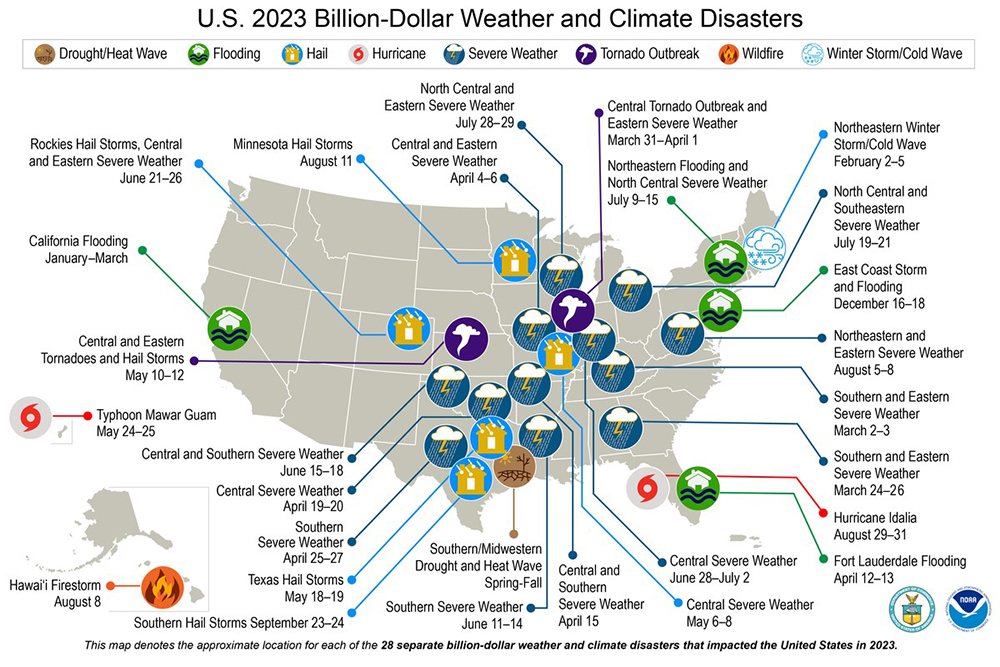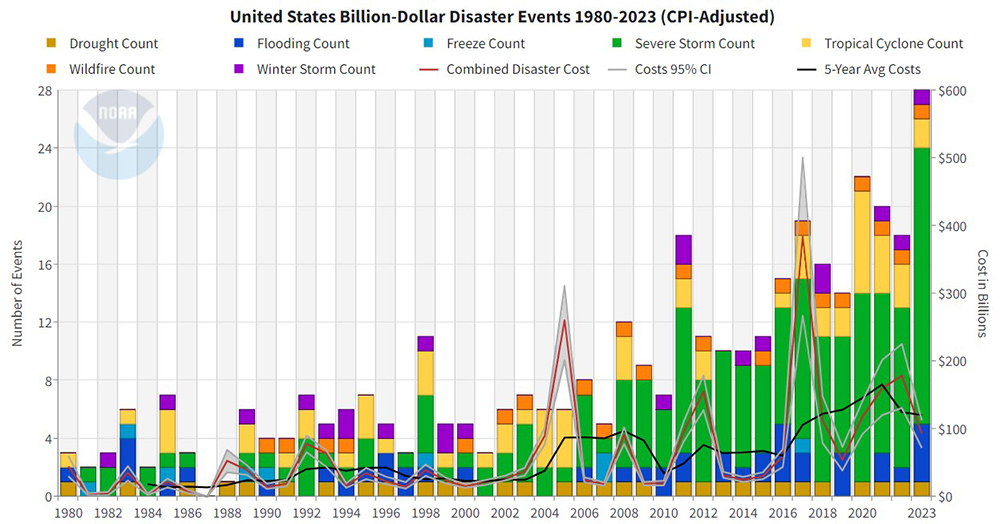The amount of carbon dioxide in the atmosphere since the mid-20th century is unprecedented compared to that of the millennia.
 Source: Climate Change: Vital Signs of the Planet - NASA.
Source: Climate Change: Vital Signs of the Planet - NASA.
In the last 800,000 years, there have been eight cycles of ice ages and warmer periods attributed to minor variations in the Earth's orbit. The last ice age occurred 11,700 years ago, marking the beginning of the modern climate era and human civilization. Today’s carbon dioxide concentration, 420 parts per million, has risen far above the previous maximum for the millennium.
The gas contributing the most, carbon dioxide, comes primarily from the combustion of fossil fuels. Scientists from the oil and gas industry were aware of this phenomenon in the late 1970s. The high level of carbon dioxide permitted more energy to be captured by the Earth through the known greenhouse effect. The scientists published and warned of the danger, but the industry began an unprecedented campaign of misinformation lasting decades. This extra captured energy has warmed the atmosphere, ocean, and land, and widespread and rapid changes in the atmosphere, ocean, cryosphere, and biosphere have occurred.
NASA reports
Global temperature is rising
The planet's average surface temperature has risen about 2 degrees Fahrenheit (1 degree Celsius) since the late 19th century, a change driven largely by increased carbon dioxide emissions into the atmosphere and other human activities. Most of the warming occurred in the past 40 years, with the seven most recent years being the warmest. The years 2016 and 2020 are tied for the warmest on record.
The ocean is getting warmer
The ocean has absorbed much of this increased heat, with the top 100 meters (about 328 feet) of ocean showing warming of 0.67 degrees Fahrenheit (0.33 degrees Celsius) since 1969. Earth stores 90% of the extra energy in the ocean.
The ice sheets are shrinking
The Greenland and Antarctic ice sheets have decreased in mass. Data from NASA's Gravity Recovery and Climate Experiment show Greenland lost an average of 279 billion tons of ice per year between 1993 and 2019, while Antarctica lost about 148 billion tons of ice per year.
Glaciers are retreating
Glaciers are retreating almost everywhere around the world, including in the Alps, Himalayas, Andes, Rockies, Alaska, and Africa.
For fun, test your knowledge about glaciers and ice caps.
Snow cover is decreasing
Satellite observations reveal that the amount of spring snow cover in the Northern Hemisphere has decreased over the past five decades and that the snow is melting earlier.
Sea level is rising
Global sea level rose about 8 inches (20 centimeters) in the last century. The rate in the last two decades, however, is nearly double that of the last century and accelerating slightly every year.
Arctic sea ice is declining
Both the extent and thickness of Arctic sea ice have declined rapidly over the last several decades. 11Image: Visualization of the 2012 Arctic sea ice minimum, the lowest on record.
Ocean acidification is increasing
Since the beginning of the Industrial Revolution, the acidity of surface ocean waters has increased by about 30%. This increase is due to humans emitting more carbon dioxide into the atmosphere and, hence, more being absorbed into the ocean. The ocean has absorbed between 20% and 30% of total anthropogenic carbon dioxide emissions in recent decades (7.2 to 10.8 billion metric tons per year).
Extreme events are increasing in frequency
The number of record high temperature events In the United States has been increasing, while the number of record low temperature events has been decreasing, since 1950. The US has also witnessed increasing numbers of intense rainfall events.”1
For your enjoyment, take the NASA quiz on the water cycle.
Let us turn our attention to the US and the year 2023.
US weather and climate situation
The National Centers for Environmental Information (NCEI) has released the final update to its 2023 disaster report, confirming a historic year in the number of costly disasters and extremes throughout much of the country2.
US 2023 highlights
There were 28 weather and climate disasters in 2023, surpassing the previous record of 22 in 2020, for an estimated cost of $93 billion. The US 2023 disasters are illustrated in the map below3.
US weather and climate disasters from 1980 to 2023
“Adding the 2023 events to the record that began in 1980, the US has sustained 376 weather and climate disasters with the overall damage costs reaching or exceeding $1 billion. The cumulative cost for these 376 events exceeds $2.660 trillion”5.
The number and cost of weather and climate disasters are increasing in the United States due to a combination of increased exposure (i.e., more assets at risk), vulnerability (i.e., how much damage a hazard of given intensity—wind speed, or flood depth, for example—causes at a location), and the fact that climate change is increasing the frequency of some types of extremes that lead to billion-dollar disasters4.
“The history of billion-dollar disasters in the United States each year from 1980 to 2023, showing event type (colors), frequency (left-hand vertical axis), and cost (right-hand vertical axis.) The number and cost of weather and climate disasters are rising due to a combination of population growth and development along with the influence of human-caused climate change on some type of extreme events that lead to billion-dollar disasters”6.
Concluding remarks
NASA summarizes the evidence that high carbon dioxide concentrations in the atmosphere cause climate warming. Carbon dioxide is produced primarily by the combustion of fossil fuels. This has been known since the 1970s, and efforts to mitigate carbon emissions have a long history of procrastination. Unfortunately, mitigation has become politically divisive in the US, despite early successful policies by Republicans in environmental endeavors such as the creation of the EPA by Nixon.
There are risks to ignoring widely accepted science. The Earth will very likely keep getting warmer unless we act. Ignoring the problem will not work because climate disasters and problems will keep presenting themselves more frequently and at higher costs. There is also the moral and political issue of an older generation leaving an unsustainable Earth for the younger generations.
Instead, adaptation, fortunately, has not yet become politicized. Adaptation needs to be significantly expanded. Not all weather disasters are attributable to climate change, but it is a contributing factor, and the cost increase is alarming. The conclusion is that we need to invest more in preventive climate adaptation. Our building codes need to be revised for more severe storms; the location of buildings in areas near potential fires or flooding requires regulation. Higher sea walls should be constructed. Metros and subways need to be protected. Adaptation hopefully remains bipartisan.
In the selection of political candidates, locally and nationally, the candidates’ policies must be evidence-based and support climate adaptation.
References
1 How do we know climate change is real?
2 NOAA National Centers for Environmental Information (NCEI), U.S. Billion-Dollar Weather and Climate Disasters, 2024.
3 Ibid.
4 The Fifth National Climate Assessment.
5 2023: A historic year of U.S. billion-dollar weather and climate disasters.
6 Ibid.

















